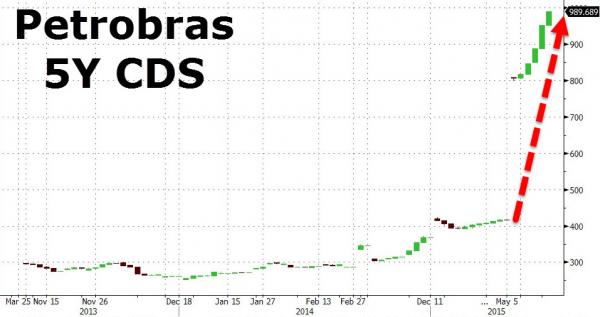There is blood on the streets wherever you look in Brazil today, but probably of most interest to the hundreds of US asset managers (the ones managing your mutual funds) is what happens to Petrobras (NYSE:PBR) as it remains so widely held. As we noted below, bond prices are collapsing and default risk is soaring, and with the nation’s currency collapsing amid the lower-for-longer oil prices, $90 billion of dollar-denominated debt could soon potentially be too burdensome for the company to repay.
Default Risk is exploding…

And as New York Shock Exchange details:
S&P recently lowered Brazil’s credit rating to junk status. It later downgraded 60 corporate and infrastructure entities in Brazil, including cutting Petrobras two notches to “BB.” Petrobras has been reeling from a corruption scandal that reportedly involved Petrobras’ executives and directors awarding suppliers over-inflated contracts in exchange for kickbacks. The scandal has cost the company billions of dollars, and has been a blow to the reputation of Brazil’s President Dilma Rousseff.
PBR is off about 70% over the past year, versus a 50% decline for the Brazilian ETF (NYSEARCA:EWZ) and flat growth for the S&P 500 (NYSEARCA:SPY). Investors should continue to avoid PBR for the following reasons:
Stagnant Revenue And Earnings
When it rains, it pours for Petrobras. In addition to the corruption scandal, a free fall in oil prices has stymied the company’s revenue growth. For the first half of 2015, Petrobras’ revenue was down 27% Y/Y from $71.4 billion to $52.0 billion, while EBITDA growth was flat. EBITDA margin increased to 26% in the first half of 2015 from 19% in the year-earlier period, as the company slashed cost of sales, SG&A expense and R&D.
To stem cash burn, Petrobras slashed its five-year capital spending by 40% and has been cancelling drilling contracts with suppliers such as Sete Brasil and Vantage Drilling (NYSEMKT:VTG). These are prudent steps given that oil prices are off 60% from their Q2 2014 peak and the global economy is showing signs of slowing. If sub-$60 oil prices are the new normal, stagnant revenue and earnings growth may be in the cards regardless of the company’s cost-cutting measures.









Leave A Comment